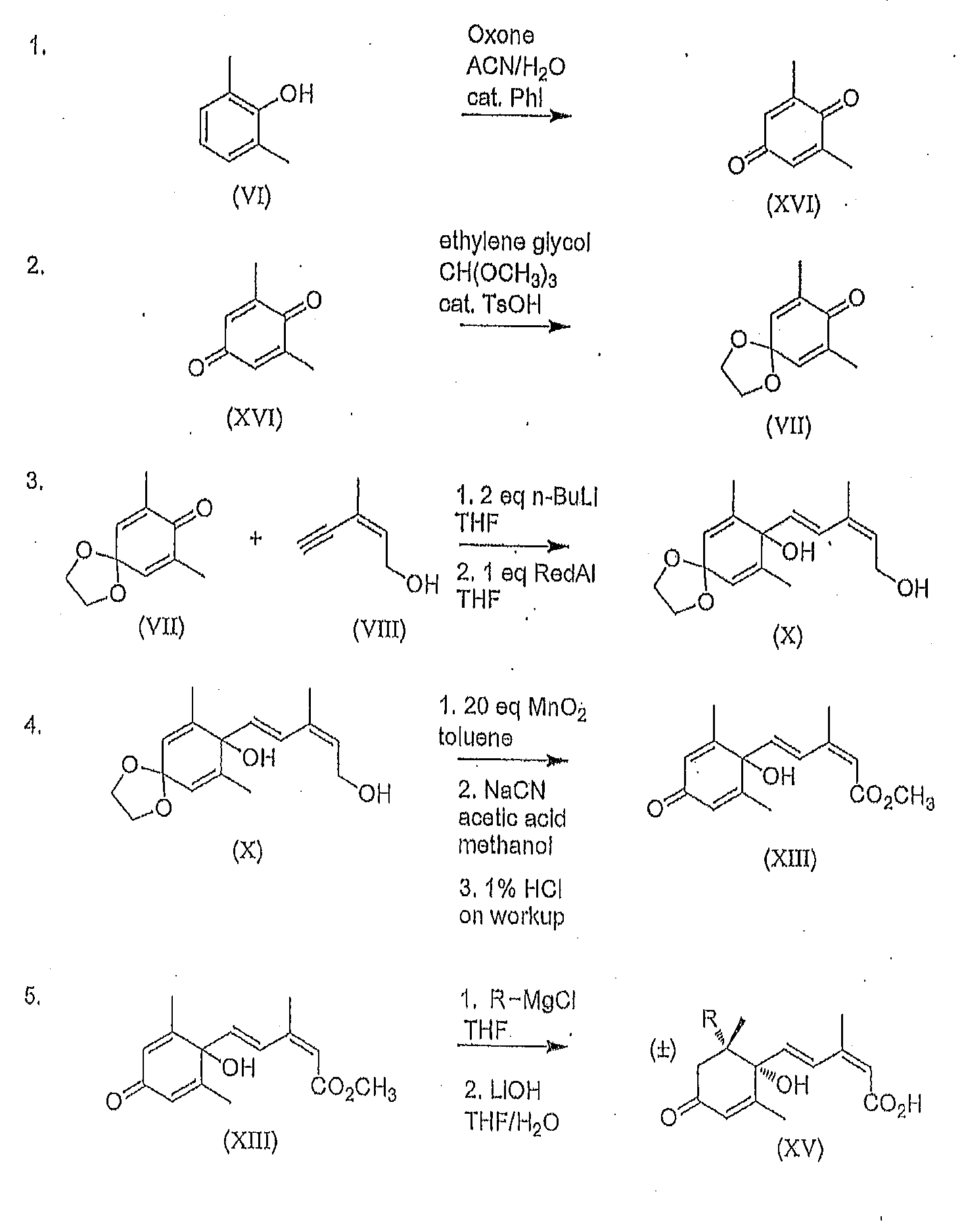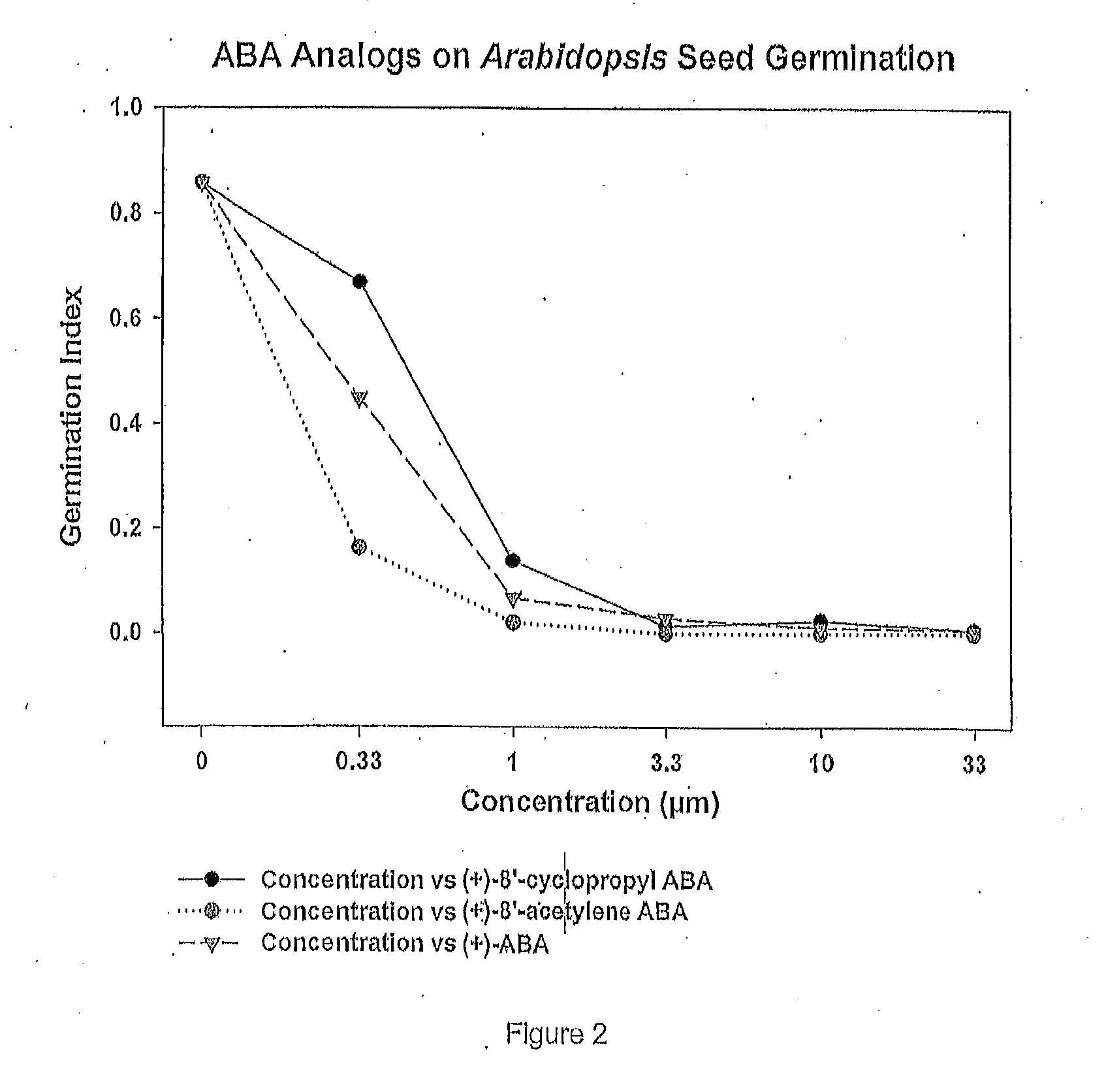Efficient scalable syntheses of abscisic acid, 8'-acetylene abscisic acid and 8'-cyclopropyl abscisic acid
a technology of cyclopropyl abscisic acid and abscisic acid, which is applied in the field of plant hormones, can solve the problems of short-lived effects, limited use, and inefficient processes, and achieves optimized ester hydrolysis procedures, reduced solvent use, and high yield and consistency
- Summary
- Abstract
- Description
- Claims
- Application Information
AI Technical Summary
Benefits of technology
Problems solved by technology
Method used
Image
Examples
example 1
Oxidation of Phenol Using potassium peroxymonosulfate
[0086]A well stirred suspension of potassium peroxymonosulfate (205 mmol) in acetonitrile (25 mL) and water (50 mL) was heated to 50° C. To this suspension was added the 2,6-dimethylphenol (41 mmol) and iodobenzene (4.1 mmol). After the reaction was complete, the mixture was allowed to cool to room temperature then filtered through a glass sintered funnel to remove the undissolved salts. The filtered salts were washed with hexanes / diethyl ether (9:1 v / v) until all of the yellow color had been washed off. The aqueous layers were extracted with hexanes / diethyl ether (9:1 v / v, 3×mL). The combined organic layers were dried with Na2SO4, filtered through a small plug of silica gel 60 and evaporated to dryness.
example 2
Production of 7,9-Dimethyl1,4-dioxaspiro[4.5]deca-6,9-dien-8-One or 2,6-Dimethyl-1,4-benzoquinone, mono ketal (VII)
[0087]2,6-Dimethylbenzoquinone (1.00 g, 7.4 mmol) was dissolved in (MeO)3CH (1.69 mL, 15,4 mmol) and placed in a 40° C. bath. Ethylene glycol (35 mL) and TsOH.H2O (141 mg, 0.74 mmol) were then added. When the internal temperature had reached 40° C., catalyst was added. The reaction was monitored by gas chromatography. After 2 h, the reaction was quenched using saturated NaHCO3 (25 mL) to neutralize the acid. The product was extracted Into 10% ether / 90% hexanes (v / v). The organic layers were dried with Na2SO4 and concentrated under reduced pressure. 2,6-Dimethyl-1,4-benzoquinone, mono ketal (VII) was isolated as a beige solid in 90% yield. Further purification was by recrystallization from hexanes.
example 3
Production of (2Z,4E)-5-(2′,6′-Dimethyl-4′,4′-ethylenedioxy-1′-hydroxycyclohexa-2′,5′-dienyl)-3-methylpent-2,4-dien-1-ol (X)
[0088]Freshly distilled (Z)-3-methylpent-2-en-4-yn-1-ol (VIII) (11.7 g, 122 mmol) was dissolved in THF (500 mL) and cooled using a dry ice / ethanol bath under Argon for 30 min. with vigorous mechanical stirring. After the internal temperature reached −63° C., n-BuLi [2,5 M] (97.7 mL, 244 mmol) was slowly added using a syringe pump over 45 min. to give a pale yellow solution. After 4-5 h at −63 to −65° C., 2,6-dimethylbenzoquinone, mono ketal (VII) (20.0 g, 111 mmol), dissolved in THF (25 mL), was added slowly using a syringe pump to the reaction mixture over 1.5 h to give a yellowish green solution. The reaction mixture was stirred at this temperature for 4 h, then slowly warmed to −20° C. over 12 h. After all ketone (VII) had reacted (i.e. full conversion to intermediate as determinded by 1H NMR of an aliquot taken), Red-Al (33.8 mL, 111 mmol) was added to the ...
PUM
| Property | Measurement | Unit |
|---|---|---|
| temperature | aaaaa | aaaaa |
| temperature | aaaaa | aaaaa |
| temperature | aaaaa | aaaaa |
Abstract
Description
Claims
Application Information
 Login to View More
Login to View More - R&D
- Intellectual Property
- Life Sciences
- Materials
- Tech Scout
- Unparalleled Data Quality
- Higher Quality Content
- 60% Fewer Hallucinations
Browse by: Latest US Patents, China's latest patents, Technical Efficacy Thesaurus, Application Domain, Technology Topic, Popular Technical Reports.
© 2025 PatSnap. All rights reserved.Legal|Privacy policy|Modern Slavery Act Transparency Statement|Sitemap|About US| Contact US: help@patsnap.com



